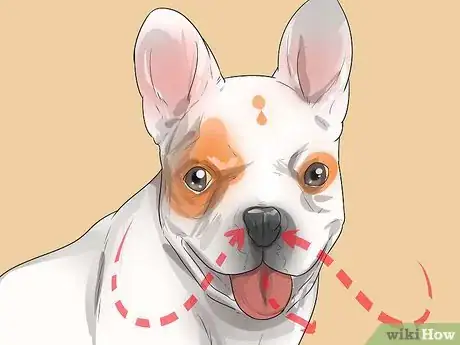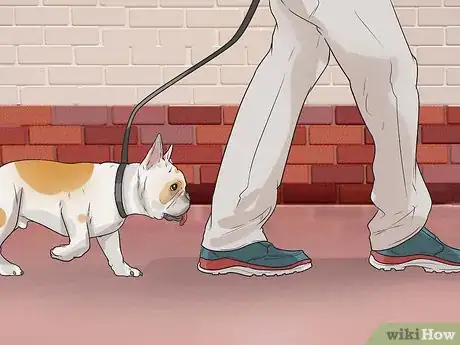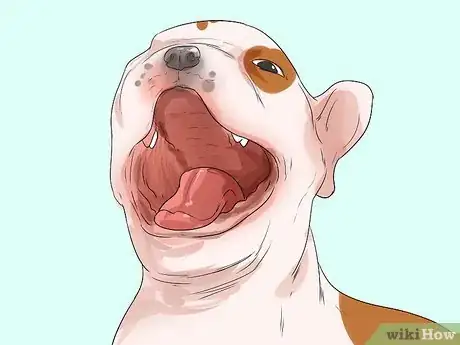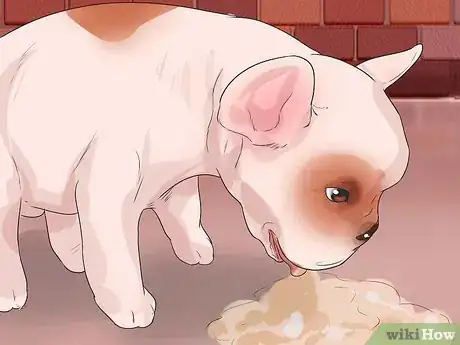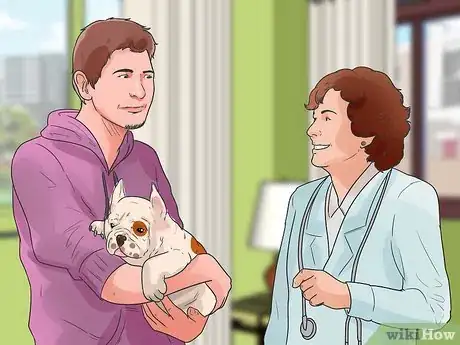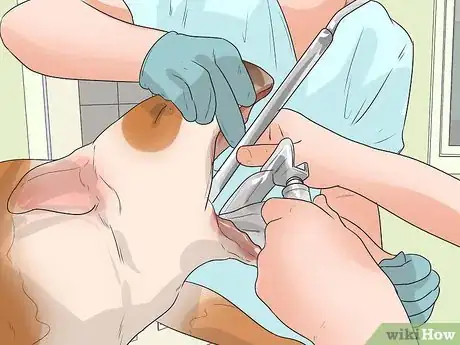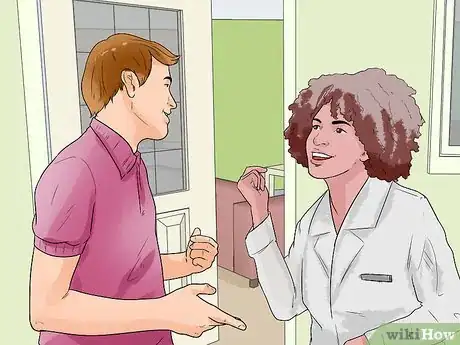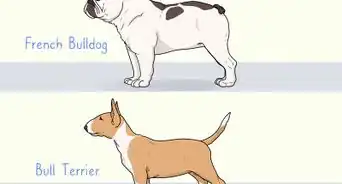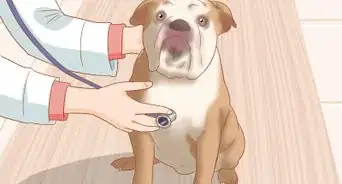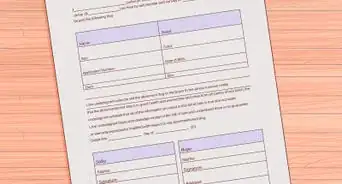This article was co-authored by Kateryna Zabashta and by wikiHow staff writer, Jessica Gibson. Kateryna Zabashta is a Dog Breeder and the Owner of Emma’s Frenchies in the San Francisco Bay Area. With over five years of experience, Kateryna specializes in dog nutrition, general care, and breeding French Bulldogs.
There are 7 references cited in this article, which can be found at the bottom of the page.
This article has been viewed 104,876 times.
If you have a French bulldog or "Frenchie", you're probably familiar with his affectionate, fun loving, and loyal nature. There are several positive characteristics to the breed. They make good watchdogs, don't require much space or exercise, and they respond well to reward-based training methods. Unfortunately, their small stature and weight can cause breathing problems. The French Bulldog's respiratory tract can make it difficult to breathe, especially when it's hot or when the dog pants heavily after exercising.[1] [2]
Steps
Watching for Breathing Problems
-
1Listen to your French Bulldog breathe. Under normal conditions (in cool weather and when your dog is not under stress), you'll probably hear some noisy breathing that doesn't bother him. But, if you close your eyes and hear noisy breathing that sounds like honking or rasping, your French Bulldog may have a breathing problem.[3]
- Breathing noise is caused by the compressed anatomy of the French Bulldog's airways. The noisier the breathing, the worse the condition.[4]
-
2Monitor your dog during exercise. If your dog is reluctant to exercise or lags behind on walks, he may be having trouble breathing. You may notice your French Bulldog pant heavily with his tongue lolling out.[5]
- If your dog has breathing problems, exercise will place extra demands on his body. For example, his body will need more oxygen which he can't supply because he physically can't draw extra air in.
- Your dog might also sound like they're growling when they're cooling down from exercise.[6]
Advertisement -
3Look inside your dog's mouth. If your French Bulldog is really struggling to breathe and is not getting enough oxygen, the membranes of his mouth and tongue will look blue or purple. Healthy membranes should appear pink.
- You may also see your dog drooling. This is because he is concentrating so hard on breathing that he doesn't want to take time out to swallow.[7]
-
4Monitor your French Bulldog's behavior. Your dog may collapse or faint if he is overtired and not getting enough oxygen. You may notice your dog seem uncomfortable or restless in hotter weather, when it's harder for him to breathe. Other signs of breathing problems include:[8]
- Snorting
- Choking
- Vomiting
- Gagging
Getting a Vet's Diagnosis
-
1Take your French Bulldog to the veterinarian. The vet will watch your dog's breathing and chest movements. The vet will also look for physical landmarks that would make it hard for your dog to breathe, like narrow nostrils or a large tongue that blocks the back of the throat. Listening to noisy breathing is also important in diagnosing breathing problems, so the veterinarian will listen to your dog's chest, heart, and lungs with a stethoscope. This can help rule out signs of chest infections and heart murmurs which creates fluid buildup in the lungs. Both of these conditions can contribute to breathing problems.
- A normal dog's chest moves in and out when he breathes, but his abdomen does not. If the vet notices your dog using his abdominal muscles to breathe (abdominal effort), it means your dog is struggling to take breaths.[9]
- The vet will check the heart and lungs because it could impact the safety of an anesthetic during surgery.
-
2Get your dog's throat examined. The veterinarian will want to thoroughly examine the back of your dog's throat. Your dog will need anesthetic and sedation so that the veterinarian can pull his tongue far enough forward to see the area. An endotracheal tube will be inserted to keep his airway open while he's asleep.[10]
- There is a risk associated with anesthesia because the dog can no longer protect his airway. This is why the intratracheal tube is put into the windpipe.
-
3Consider further testing. If your veterinarian suspects that some other condition is causing the symptoms, additional testing might be needed. Chest x-rays can help rule out pneumonia, lungworm, or cancer. Advanced imaging techniques like MRI or CT scans can also help the veterinarian visualize your French Bulldog's anatomy (specifically the soft palate, windpipe, and tonsils).[11]
- It's important for your veterinarian to know the length of your dog's palate, size of his tongue, and the size of his tonsils. This will help when it comes to planning corrective surgery.
-
4Follow treatment advice. The veterinarian may recommend corrective surgery to trim back and remodel your dog's nostrils and soft palate. This can improve the shape of the back of the throat and allow more air to enter the nostrils. A specialist surgeon may also want to remove the tonsils.
- While it's possible to correct some of your French Bulldog's anatomy, it is impossible to change the size of the tongue or width of the windpipe.[12]
Expert Q&A
-
QuestionHow do you avoid breathing problems if you're breeding Frenchies?
 Kateryna ZabashtaKateryna Zabashta is a Dog Breeder and the Owner of Emma’s Frenchies in the San Francisco Bay Area. With over five years of experience, Kateryna specializes in dog nutrition, general care, and breeding French Bulldogs.
Kateryna ZabashtaKateryna Zabashta is a Dog Breeder and the Owner of Emma’s Frenchies in the San Francisco Bay Area. With over five years of experience, Kateryna specializes in dog nutrition, general care, and breeding French Bulldogs.
Dog Breeder Don't breed animals that have those breathing problems. Also, avoid breeding them to get a really small size—usually to do that, you're breeding the runt of the litter with another runt. Those tend to be the weaker dogs in the litter, so you may be more likely to end up with health problems in the puppies.
Don't breed animals that have those breathing problems. Also, avoid breeding them to get a really small size—usually to do that, you're breeding the runt of the litter with another runt. Those tend to be the weaker dogs in the litter, so you may be more likely to end up with health problems in the puppies.
References
- ↑ http://www.allstarfrenchbulldogs.com/BrachycephalicSyndrome.htm
- ↑ http://dogtime.com/dog-breeds/french-bulldog
- ↑ Kateryna Zabashta. Dog Breeder. Expert Interview. 19 March 2021.
- ↑ http://www.vcahospitals.com/main/pet-health-information/article/animal-health/brachycephalic-airway-syndrome-in-dogs/2143
- ↑ http://www.allstarfrenchbulldogs.com/FrenchBulldogHealthIssues.htm
- ↑ Kateryna Zabashta. Dog Breeder. Expert Interview. 19 March 2021.
- ↑ http://www.allstarfrenchbulldogs.com/FrenchBulldogHealthIssues.htm
- ↑ http://www.vcahospitals.com/main/pet-health-information/article/animal-health/brachycephalic-airway-syndrome-in-dogs/2143
- ↑ Small Animal internal medicine. Nelson & Couto. Publisher: Mosby.
- ↑ http://www.allstarfrenchbulldogs.com/BrachycephalicSyndrome.htm
- ↑ Small Animal internal medicine. Nelson & Couto. Publisher: Mosby.
- ↑ Small Animal internal medicine. Nelson & Couto. Publisher: Mosby.
About This Article
To diagnose breathing problems in your French bulldog, listen for a rasping sound when it breathes. Additionally, watch to see if your dog lags behind or breathes with its tongue lolling out while walking, which are signs it’s struggling for air. Alternatively, look inside its mouth to see if its tongue is blue or purple, which indicates its not getting enough oxygen. You may also notice your dog collapsing or fainting from being overtired, especially in hot weather. For tips on how to get effective treatment for your dog's breathing problems, read on!
